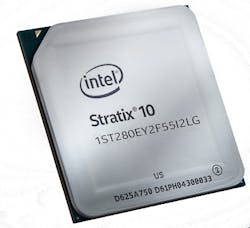Intel ships first 58Gbps FPGA transceivers for 400G Ethernet deployments
At the Optical Fiber Communications (OFC 2019) conference in San Diego (March 3-7), Intel’s Programmable Solutions Group showcased its 58Gbps transceiver technology integrated on the Intel Stratix 10 TX FPGA, billed by the manufacturer as "the world’s first field programmable gate array (FPGA) with 58Gbps PAM4 transceiver technology, now shipping in volume production and enabling 400Gb Ethernet deployment."
Intel contends that the new technology doubles transceiver bandwidth performance when compared to traditional solutions, and is critical for applications where high bandwidth is paramount, including: networking, cloud and 5G applications, optical transport networks, enterprise networking, cloud service providers, and 5G.
By supporting dual-mode modulation, 58Gbps PAM4 and 30Gbps NRZ, new infrastructure can reach 58Gbps data rates while staying backward-compatible with existing network infrastructure, notes Intel. Further, the Stratix 10 TX FPGA with 58Gbps PAM4 transceiver technology provides system architects with higher transceiver bandwidth and hardened IP to address the insatiable demand for faster and higher density connectivity.
Intel names Robert Swan as CEO to focus on data center, A.I. challenges
To facilitate the future of networking, Network Function Virtualization (NFV) and optical transport solutions, Intel Stratix 10 TX FPGAs provide up to 144 transceiver lanes with serial data rates of 1 to 58Gbps. Intel says this combination delivers a higher aggregate bandwidth than any current FPGA, enabling architects to scale to 100Gb, 200Gb and 400Gb delivery speeds. A wide range of hardened intellectual property cores, including 100Gb MAC and FEC, deliver optimized performance, latency and power.
Moreover, the Intel Stratix 10 FPGA 58Gbs transceivers are interoperable with 400G Ethernet FPGAs, using only eight channels to support new high-bandwidth requirements for routers, switches, active optical cables and direct attach cables, interconnects, and test and measurement equipment.
“The 400Gb Ethernet and QSFP-DD market is evolving at a fast pace. And being first to market with a portable solution is instrumental to enable the transition from lab to the field. We were excited to work closely with Intel to deliver our next-generation test module with the only production FPGA technology supporting native 58Gbps PAM4,” commented Ildefonso M. Polo, vice president of Product Marketing at VeEX.
400G QSFP-DD transceiver unveiled at OFC 2018
“As we continue to deliver product innovations and capabilities that allow for higher data ingest and processing speeds critical for networking and data center applications, this is a powerful example of how Intel FPGAs bring real value to our customers,” concludes Dan McNamara, Intel senior vice president and general manager of the Programmable Solutions Group.
